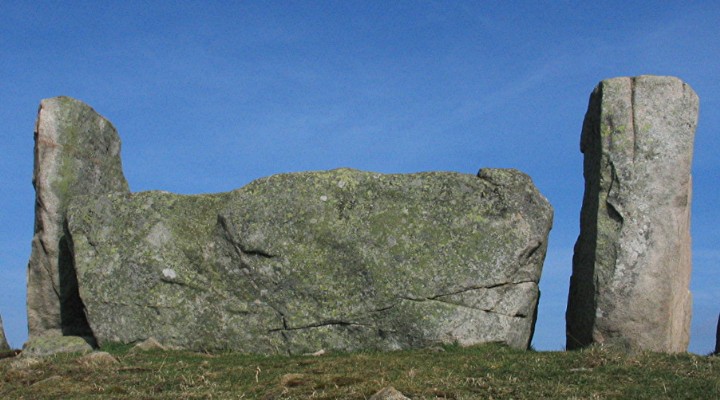
The recumbent and flankers from inside the circle. The recumbent, at 4.5m, is amongst the longest.

The recumbent and flankers from inside the circle. The recumbent, at 4.5m, is amongst the longest.

The “other half” of the circle.

The northern outlier aka the Balbair Stone. 2.6m

The “western outlier” – 1.3m high but described by Canmore as a cattle rubbing stone.

Recumbent and flankers from outside the circle.

Recumbent and flankers from inside the circle.

A view across the circle.

The E half (roughly) of the circle.
The outer stones are the circle stones; the inner stones belong to the ring cairn.

The site in 1987. Note the fallen flankers.

Recumbent (3.1m) and west flanker from inside the circle.

View over the fallen east flanker.

Looking SE

Recumbent and flankers from outside the circle.

Recumbent and flankers from inside the circle.

Five of the other circle stones + the bank the circle sits on.

Recumbent and flankers from the inside.

Recumbent and flankers from the outside.

Looking W roughly.
Recumbent and flankers + two others.

The cup marks on the external face of the recumbent.

The external face of the recumbent and flankers.

The recumbent and flankers from inside the circle. The ranging pole is 1m high.

Looking SW showing the recumbent and flankers and three of the four other upright stones (the fourth is quite small).

The outliers and the circle. Looking W.

The two outliers 200m E of the circle (2.0m & 1.8m). Looking SW.

The recumbent and flankers from inside the circle. Note how level the recumbent is.

The recumbent and flankers from outside the circle.

From just outside the circle showing the recumbent and flankers and the only other upright stone (2.9m).

The view from the road looking NNE showing all that survives of this circle.

The recumbent and east flanker from outside the circle. The ranging pole is 1m high.

Looking SE across the remains of the circle.

The two surviving stones on the W of the circle – 1.7m (L) and 2.2m.

Looking NE

Looking NE. The recumbent is 4.5m long.

The recumbent and east flanker from outside the circle.

The recumbent and the east flanker from inside the circle.

Looking SW with the three surviving upright stones, the recumbent and the east flanker.

The site in 1987 – surrounded by trees.

Looking NE.
The boulder is roughly 1.25m across.

Another view showing more of the decorations on the S part of the stone.

The cup and five rings with groove here shows up detail which Morris described in 1981 as having weathered off.

Location view.
You approach the site from the trees at the top left.

It’s difficult to get a good view of this from the ground.
These two views cover most of the cairn.
Looking S on the left. The cairn continues beyond the tree and ends at the mound which is just visible.
Looking N on the right. The cairn ends at the distant tree.

The S end.
Some stones of a possible chamber can be seen to the right.

The chamber.

From The Prehistoric Rock Art of Southern Scotland by Ronald W B Morris (1981).
Morris has based this drawing on a late 19th C sketch by Donnelly contained in the Bruce paper referenced in the PSAS link but has added, at the lettered areas, details from other plans.

The Cochno Stone today.